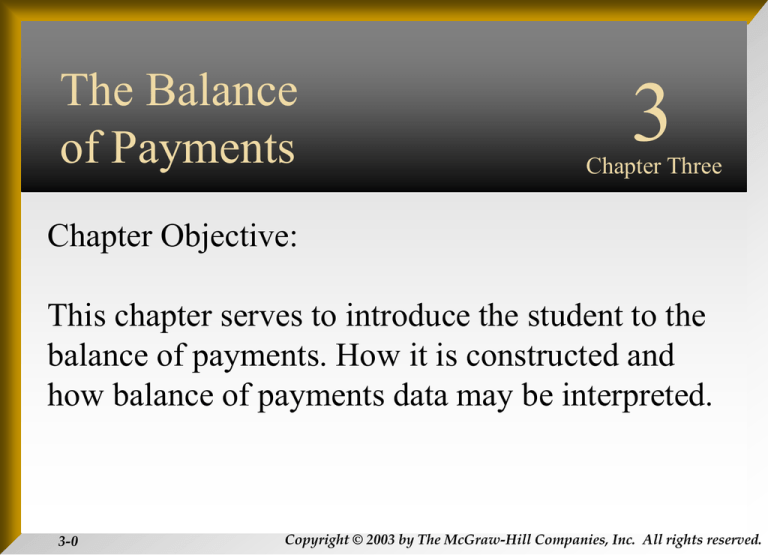
The Balance
of Payments
Chapter Objective:
3
Chapter Three
INTERNATIONAL
FINANCIAL
MANAGEMENT
This chapter serves to introduce the student to the
balance of payments. How it is constructed and
Third Edition
how balance of payments data may be interpreted.
EUN / RESNICK
3-0
Copyright © 2003 by The McGraw-Hill Companies, Inc. All rights reserved.
Chapter Three Outline
Balance of Payments Accounting
Balance of Payments Accounts
3-1
The Current Account
The Capital Account
Statistical Discrepancy
Official Reserves Account
The Balance of Payments Identity
Balance of Payments Trends in Major
Countries
Copyright © 2003 by The McGraw-Hill Companies, Inc. All rights reserved.
Balance of Payments Accounting
The Balance of Payments is the statistical record
of a country’s international transactions over a
certain period of time presented in the form of
double-entry bookkeeping.
N.B. when we say “a country’s balance of
payments” we are referring to the transactions of
its citizens and government.
3-2
Copyright © 2003 by The McGraw-Hill Companies, Inc. All rights reserved.
Balance of Payments Example
3-3
Suppose that Maplewood Bicycle in
Maplewood, Missouri, USA imports
$100,000 worth of bicycle frames from
Mercian Bicycles in Darby England.
There will exist a $100,000 credit recorded
by Mercian that offsets a $100,000 debit at
Maplewood’s bank account.
This will lead to a rise in the supply of
dollars and the demand for British pounds.
Copyright © 2003 by The McGraw-Hill Companies, Inc. All rights reserved.
Balance of Payments Accounts
The balance of payments accounts are those that
record all transactions between the residents of a
country and residents of all foreign nations.
They are composed of the following:
3-4
The Current Account
The Capital Account
The Official Reserves Account
Statistical Discrepancy
Copyright © 2003 by The McGraw-Hill Companies, Inc. All rights reserved.
The Current Account
Includes all imports and exports of goods and
services.
Includes unilateral transfers of foreign aid.
If the debits exceed the credits, then a country is
running a trade deficit.
If the credits exceed the debits, then a country is
running a trade surplus.
3-5
Copyright © 2003 by The McGraw-Hill Companies, Inc. All rights reserved.
The Capital Account
The capital account measures the difference
between U.S. sales of assets to foreigners and U.S.
purchases of foreign assets.
The U.S. enjoys about a $444,000,000,000 capital
account surplus—absent of U.S. borrowing from
foreigners, this “finances” our trade deficit.
The capital account is composed of Foreign Direct
Investment (FDI), portfolio investments and other
investments.
3-6
Copyright © 2003 by The McGraw-Hill Companies, Inc. All rights reserved.
Statistical Discrepancy
There’s going to be some omissions and
misrecorded transactions—so we use a “plug”
figure to get things to balance.
Exhibit 3.1 shows a discrepancy of $0.73 billion
in 2000.
3-7
Copyright © 2003 by The McGraw-Hill Companies, Inc. All rights reserved.
The Official Reserves Account
Official reserves assets include gold, foreign
currencies, SDRs, reserve positions in the IMF.
3-8
Copyright © 2003 by The McGraw-Hill Companies, Inc. All rights reserved.
The Balance of Payments Identity
BCA + BKA + BRA = 0
where
BCA = balance on current account
BKA = balance on capital account
BRA = balance on the reserves account
Under a pure flexible exchange rate regime,
BCA + BKA = 0
3-9
Copyright © 2003 by The McGraw-Hill Companies, Inc. All rights reserved.
U.S. Balance of Payments Data
Credits
Debits
Current Account
1
Exports
2
Imports
3
$1,418.64
($1,809.18)
Unilateral Transfers
Balance on Current Account
Capital Account
4
5
6
Direct Investment
Portfolio Investment
Other Investments
Balance on Capital Account
7
Statistical Discrepancies
Overall Balance
Official Reserve Account
3-10
$10.24
($64.39)
($444.69)
$287.68
$474.39
$262.64
$444.26
0.73
$0.30
($152.44)
($124.94)
($303.27)
($0.30)
Copyright © 2003 by The McGraw-Hill Companies, Inc. All rights reserved.
U.S. Balance of Payments Data
Credits
Debits
Current Account
1
Exports
2
Imports
3
$1,418.64
($1,809.18)
Unilateral Transfers
Balance on Current Account
Capital Account
4
5
6
Direct Investment
Portfolio Investment
Other Investments
Balance on Capital Account
7
Statistical Discrepancies
Overall Balance
Official Reserve Account
3-11
$10.24
($64.39)
($444.69)
$287.68
$474.39
$262.64
$444.26
0.73
$0.30
($152.44)
($124.94)
($303.27)
In 2000, the
U.S. imported
more than it
exported, thus
running a
current account
deficit of
$444.69 billion.
($0.30)
Copyright © 2003 by The McGraw-Hill Companies, Inc. All rights reserved.
U.S. Balance of Payments Data
Credits
Debits
Current Account
1
Exports
2
Imports
3
$1,418.64
($1,809.18)
Unilateral Transfers
Balance on Current Account
Capital Account
4
5
6
Direct Investment
Portfolio Investment
Other Investments
Balance on Capital Account
7
Statistical Discrepancies
Overall Balance
Official Reserve Account
3-12
$10.24
($64.39)
($444.69)
$287.68
$474.39
$262.64
$444.26
0.73
$0.30
($152.44)
($124.94)
($303.27)
($0.30)
During the same
year, the U.S.
attracted net
investment of
$444.26
billion—clearly
the rest of the
world found the
U.S. to be a
good place to
invest.
Copyright © 2003 by The McGraw-Hill Companies, Inc. All rights reserved.
U.S. Balance of Payments Data
Credits
Debits
Current Account
1
Exports
2
Imports
3
$1,418.64
($1,809.18)
Unilateral Transfers
Balance on Current Account
Capital Account
4
5
6
Direct Investment
Portfolio Investment
Other Investments
Balance on Capital Account
7
Statistical Discrepancies
Overall Balance
Official Reserve Account
3-13
$10.24
($64.39)
($444.69)
$287.68
$474.39
$262.64
$444.26
0.73
$0.30
($152.44)
($124.94)
($303.27)
Under a pure
flexible
exchange rate
regime, these
numbers would
balance each
other out.
($0.30)
Copyright © 2003 by The McGraw-Hill Companies, Inc. All rights reserved.
U.S. Balance of Payments Data
Credits
Debits
Current Account
1
Exports
2
Imports
3
$1,418.64
($1,809.18)
Unilateral Transfers
Balance on Current Account
Capital Account
4
5
6
Direct Investment
Portfolio Investment
Other Investments
Balance on Capital Account
7
Statistical Discrepancies
Overall Balance
Official Reserve Account
3-14
$10.24
($64.39)
($444.69)
$287.68
$474.39
$262.64
$444.26
0.73
$0.30
($152.44)
($124.94)
($303.27)
In the real
world, there
is a statistical
discrepancy.
($0.30)
Copyright © 2003 by The McGraw-Hill Companies, Inc. All rights reserved.
U.S. Balance of Payments Data
Credits
Debits
Current Account
1
Exports
2
Imports
3
$1,418.64
($1,809.18)
Unilateral Transfers
Balance on Current Account
Capital Account
4
5
6
Direct Investment
Portfolio Investment
Other Investments
Balance on Capital Account
7
Statistical Discrepancies
Overall Balance
Official Reserve Account
$10.24
($64.39)
($444.69)
$287.68
$474.39
$262.64
$444.26
0.73
$0.30
($152.44)
($124.94)
($303.27)
Including that,
the balance of
payments identity
should hold:
BCA + BKA = – BRA
($0.30)
($444.69) + $444.26 + $0.73 = $0.30= –($0.30)
3-15
Copyright © 2003 by The McGraw-Hill Companies, Inc. All rights reserved.
Balance of Payments and the
Exchange Rate
Credits
Debits
Exchange rate $
Current Account
1
Exports
2
Imports
3
Direct Investment
Portfolio Investment
Other Investments
Balance on Capital Account
7
Statistical Discrepancies
Overall Balance
Official Reserve Account
3-16
S
($1,809.18)
Unilateral Transfers
Balance on Current Account
Capital Account
4
5
6
P
$1,418.64
$10.24
($64.39)
($444.69)
$287.68
$474.39
$262.64
$444.26
0.73
$0.30
($152.44)
($124.94)
($303.27)
D
Q
($0.30)
Copyright © 2003 by The McGraw-Hill Companies, Inc. All rights reserved.
Balance of Payments and the
Exchange Rate
Credits
Debits
Exchange rate $
Current Account
1
Exports
2
Imports
3
Direct Investment
Portfolio Investment
Other Investments
Balance on Capital Account
7
Statistical Discrepancies
Overall Balance
Official Reserve Account
S
($1,809.18)
Unilateral Transfers
Balance on Current Account
Capital Account
4
5
6
P
$1,418.64
$10.24
($64.39)
($444.69)
$287.68
$474.39
$262.64
$444.26
0.73
$0.30
($152.44)
($124.94)
($303.27)
D
Q
($0.30)
As U.S. citizens import, they are supply dollars to the FOREX market.
3-17
Copyright © 2003 by The McGraw-Hill Companies, Inc. All rights reserved.
Balance of Payments and the
Exchange Rate
Credits
Debits
Exchange rate $
Current Account
1
Exports
2
Imports
3
Direct Investment
Portfolio Investment
Other Investments
Balance on Capital Account
7
Statistical Discrepancies
Overall Balance
Official Reserve Account
S
($1,809.18)
Unilateral Transfers
Balance on Current Account
Capital Account
4
5
6
P
$1,418.64
$10.24
($64.39)
($444.69)
$287.68
$474.39
$262.64
$444.26
0.73
$0.30
($152.44)
($124.94)
($303.27)
D
Q
($0.30)
As U.S. citizens export, others demand dollars at the FOREX market.
3-18
Copyright © 2003 by The McGraw-Hill Companies, Inc. All rights reserved.
Balance of Payments and the
Exchange Rate
Credits
Debits
Exchange rate $
Current Account
1
Exports
2
Imports
3
($1,809.18)
Unilateral Transfers
Balance on Current Account
Capital Account
4
5
6
Direct Investment
Portfolio Investment
Other Investments
Balance on Capital Account
7
Statistical Discrepancies
Overall Balance
Official Reserve Account
P
$1,418.64
$10.24
($64.39)
($444.69)
$287.68
$474.39
$262.64
$444.26
0.73
$0.30
($152.44)
($124.94)
($303.27)
S
S1
D
Q
($0.30)
As the U.S. government sells dollars, the supply of dollars increases.
3-19
Copyright © 2003 by The McGraw-Hill Companies, Inc. All rights reserved.
Balance of Payments Trends
Since 1982 the U.S. has experienced continuous
deficits on the current account and continuous
surpluses on the capital account.
During the same period, Japan has experienced the
opposite.
3-20
Copyright © 2003 by The McGraw-Hill Companies, Inc. All rights reserved.
Balances on the Current (BCA) and Capital
(BKA) Accounts of the United States
500
400
300
200
100
0
-1001982 1984 1986 1988 1990 1992 1994 1996 1998 2000
U.S. BCA
U.S. BKA
-200
-300
-400
-500
Source: IMF International Financial Statistics Yearbook, 2000
Copyright © 2003 by The McGraw-Hill Companies, Inc. All rights reserved.
3-21
Balances on the Current (BCA) and Capital
(BKA) Accounts of United Kingdom
40
30
20
10
0
-101982
UK BCA
1984
1986
1988
1990
1992
1994
1996
1998
2000
UK BKA
-20
-30
-40
-50
Source: IMF International Financial Statistics Yearbook, 2000
Copyright © 2003 by The McGraw-Hill Companies, Inc. All rights reserved.
3-22
Balances on the Current (BCA) and Capital
(BKA) Accounts of Japan
150
100
50
0
1982 1984 1986 1988 1990 1992 1994 1996 1998 2000
-50
Japan BCA
Japan BKA
-100
-150
Source: IMF International Financial Statistics Yearbook, 2000
Copyright © 2003 by The McGraw-Hill Companies, Inc. All rights reserved.
3-23
Balances on the Current (BCA) and Capital
(BKA) Accounts of Germany
80
60
40
20
0
1982 1984 1986 1988 1990 1992 1994 1996 1998 2000
-20
Germany BCA
Germany BKA
-40
-60
-80
Source: IMF International Financial Statistics Yearbook, 2000
Copyright © 2003 by The McGraw-Hill Companies, Inc. All rights reserved.
3-24
Balances on the Current (BCA) and Capital
(BKA) Accounts of China
35
30
25
20
15
10
5
China BCA
China BKA
0
-51982 1984 1986 1988 1990 1992 1994 1996 1998 2000
-10
-15
Source: IMF International Financial Statistics Yearbook, 2000
Copyright © 2003 by The McGraw-Hill Companies, Inc. All rights reserved.
3-25
Balance of Payments Trends
Germany traditionally had current account
surpluses.
Since 1991 Germany has been experiencing
current account deficits.
This is largely due to German reunification and
the resultant need to absorb more output
domestically to rebuild the former East Germany.
What matters is the nature and causes of the
disequilibrium.
3-26
Copyright © 2003 by The McGraw-Hill Companies, Inc. All rights reserved.
Balances on the Current (BCA) and Capital
(BKA) Accounts of Five Major Countries
500
China BCA
400
China BKA
300
Japan BCA
200
Japan BKA
100
0
-1001982
-200
-300
Germany BCA
1984
1986
1988
1990
1992
1994
1996
1998
2000
Germany BKA
UK BCA
UK BKA
-400
U.S. BCA
-500
U.S. BKA
Source: IMF International Financial Statistics Yearbook, 2000
Copyright © 2003 by The McGraw-Hill Companies, Inc. All rights reserved.
3-27
End Chapter Three
3-28
Copyright © 2003 by The McGraw-Hill Companies, Inc. All rights reserved.








